Knowledge Management: A Comparative Case Study of McKinsey and NASA
VerifiedAdded on 2020/12/26
|10
|3535
|149
Case Study
AI Summary
This case study analyzes knowledge management practices at McKinsey and NASA, focusing on the SECI model (Socialization, Externalization, Combination, and Internalization). The introduction defines knowledge management and its importance, particularly within McKinsey. The study examines how the SECI model is applied to convert tacit and explicit knowledge in both organizations. Findings include an explanation of the SECI model and its components, the outcomes of applying the theory to McKinsey and NASA (including the NASA shuttle disaster), and a comparison of these applications. The analysis evaluates the effectiveness of the SECI model in analyzing the case studies, revealing insights into the organizational contexts of McKinsey and NASA. It also discusses the successes and problems of using the theory, and concludes with suggestions for modifying the theory. The study highlights the importance of converting informal knowledge to formal knowledge and vice-versa, and the dynamic nature of knowledge creation within organizations.
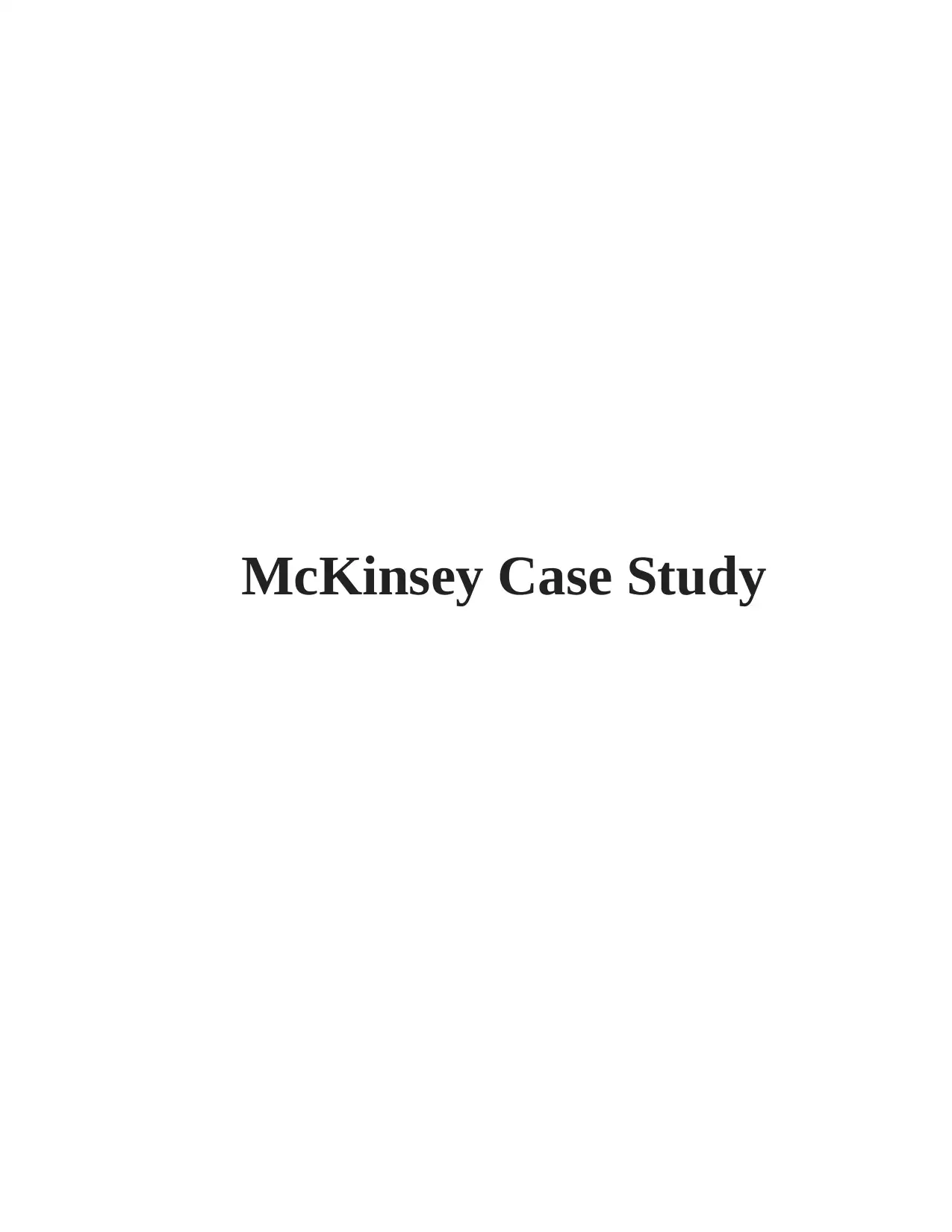
McKinsey Case Study
Paraphrase This Document
Need a fresh take? Get an instant paraphrase of this document with our AI Paraphraser
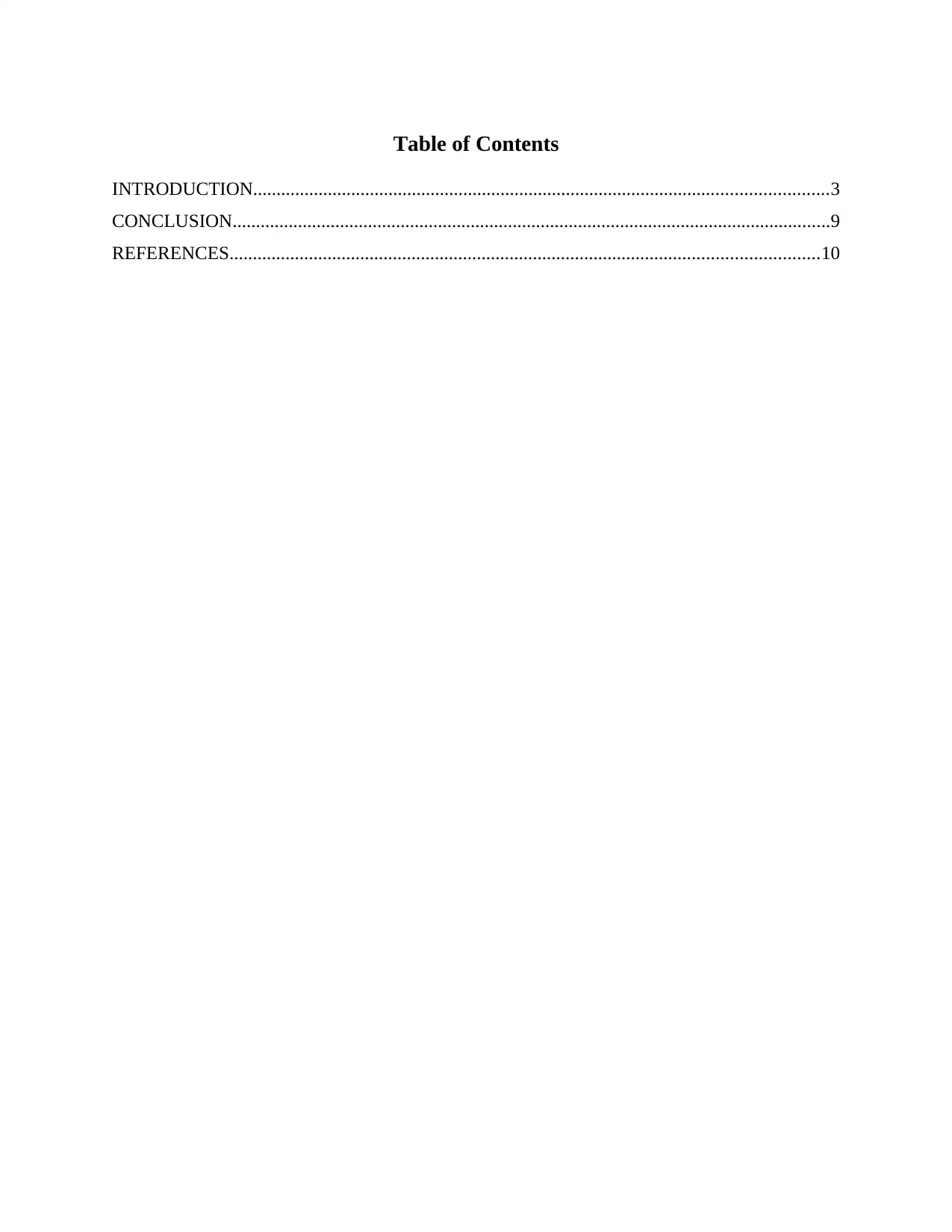
Table of Contents
INTRODUCTION...........................................................................................................................3
CONCLUSION................................................................................................................................9
REFERENCES..............................................................................................................................10
INTRODUCTION...........................................................................................................................3
CONCLUSION................................................................................................................................9
REFERENCES..............................................................................................................................10
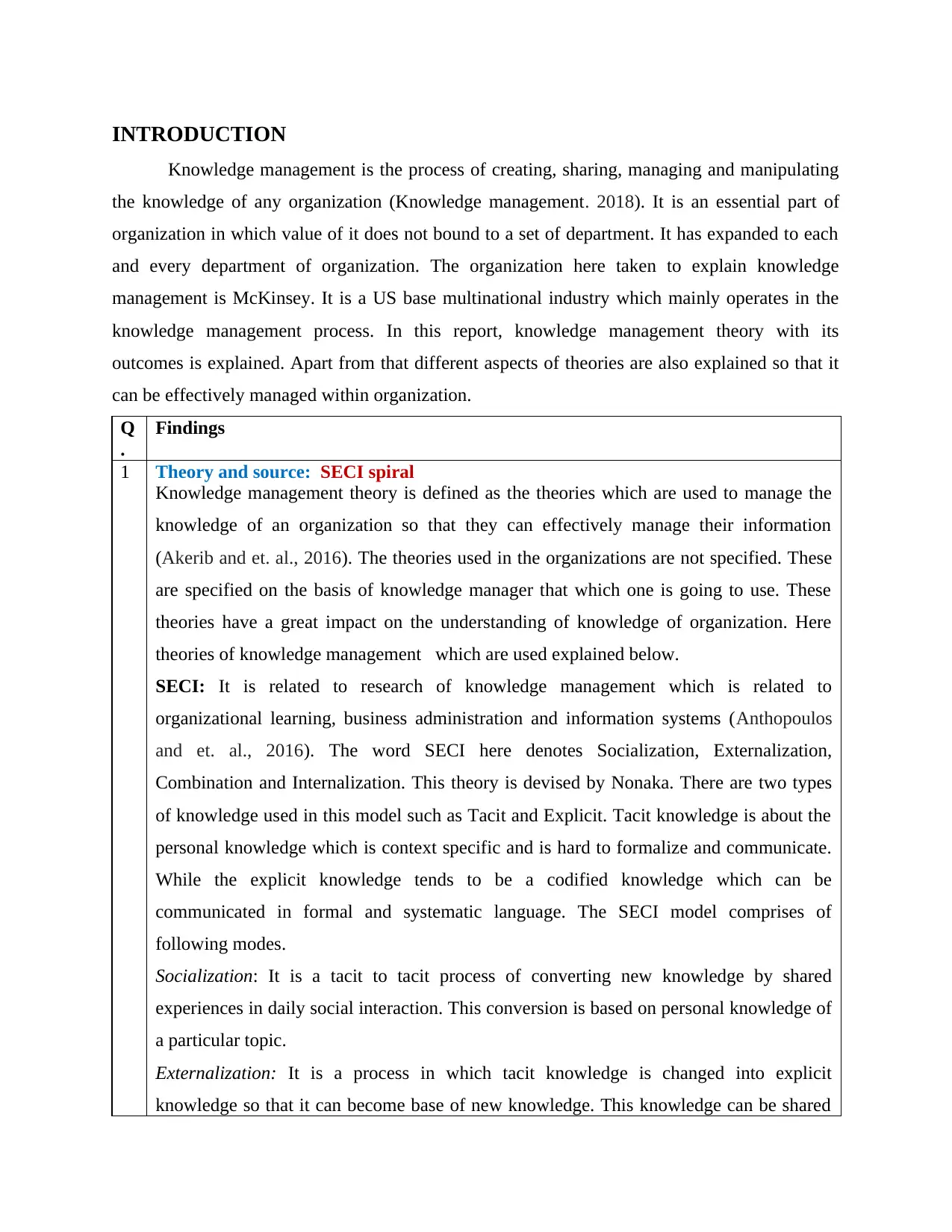
INTRODUCTION
Knowledge management is the process of creating, sharing, managing and manipulating
the knowledge of any organization (Knowledge management. 2018). It is an essential part of
organization in which value of it does not bound to a set of department. It has expanded to each
and every department of organization. The organization here taken to explain knowledge
management is McKinsey. It is a US base multinational industry which mainly operates in the
knowledge management process. In this report, knowledge management theory with its
outcomes is explained. Apart from that different aspects of theories are also explained so that it
can be effectively managed within organization.
Q
.
Findings
1 Theory and source: SECI spiral
Knowledge management theory is defined as the theories which are used to manage the
knowledge of an organization so that they can effectively manage their information
(Akerib and et. al., 2016). The theories used in the organizations are not specified. These
are specified on the basis of knowledge manager that which one is going to use. These
theories have a great impact on the understanding of knowledge of organization. Here
theories of knowledge management which are used explained below.
SECI: It is related to research of knowledge management which is related to
organizational learning, business administration and information systems (Anthopoulos
and et. al., 2016). The word SECI here denotes Socialization, Externalization,
Combination and Internalization. This theory is devised by Nonaka. There are two types
of knowledge used in this model such as Tacit and Explicit. Tacit knowledge is about the
personal knowledge which is context specific and is hard to formalize and communicate.
While the explicit knowledge tends to be a codified knowledge which can be
communicated in formal and systematic language. The SECI model comprises of
following modes.
Socialization: It is a tacit to tacit process of converting new knowledge by shared
experiences in daily social interaction. This conversion is based on personal knowledge of
a particular topic.
Externalization: It is a process in which tacit knowledge is changed into explicit
knowledge so that it can become base of new knowledge. This knowledge can be shared
Knowledge management is the process of creating, sharing, managing and manipulating
the knowledge of any organization (Knowledge management. 2018). It is an essential part of
organization in which value of it does not bound to a set of department. It has expanded to each
and every department of organization. The organization here taken to explain knowledge
management is McKinsey. It is a US base multinational industry which mainly operates in the
knowledge management process. In this report, knowledge management theory with its
outcomes is explained. Apart from that different aspects of theories are also explained so that it
can be effectively managed within organization.
Q
.
Findings
1 Theory and source: SECI spiral
Knowledge management theory is defined as the theories which are used to manage the
knowledge of an organization so that they can effectively manage their information
(Akerib and et. al., 2016). The theories used in the organizations are not specified. These
are specified on the basis of knowledge manager that which one is going to use. These
theories have a great impact on the understanding of knowledge of organization. Here
theories of knowledge management which are used explained below.
SECI: It is related to research of knowledge management which is related to
organizational learning, business administration and information systems (Anthopoulos
and et. al., 2016). The word SECI here denotes Socialization, Externalization,
Combination and Internalization. This theory is devised by Nonaka. There are two types
of knowledge used in this model such as Tacit and Explicit. Tacit knowledge is about the
personal knowledge which is context specific and is hard to formalize and communicate.
While the explicit knowledge tends to be a codified knowledge which can be
communicated in formal and systematic language. The SECI model comprises of
following modes.
Socialization: It is a tacit to tacit process of converting new knowledge by shared
experiences in daily social interaction. This conversion is based on personal knowledge of
a particular topic.
Externalization: It is a process in which tacit knowledge is changed into explicit
knowledge so that it can become base of new knowledge. This knowledge can be shared
⊘ This is a preview!⊘
Do you want full access?
Subscribe today to unlock all pages.

Trusted by 1+ million students worldwide

with others and can also be converted into tacit with one's perception.
Combination: It is the process where the explicit knowledge is taken and is operated with
modifications to provide explicit knowledge to the members of organization. It is an
explicit to explicit knowledge convertor.
Internalization: It is an explicit to tacit process in which explicit knowledge is created and
spread across the organization to form it tacit knowledge.
2 Outcome of applying theory to McKinsey and NASA
The SECI theory is applied to convert the knowledge of tacit to explicit and vice versa. In
case of McKinsey, the conversion of knowledge has become possible with the use of this
theory (Goodenberger and et. al., 2016). The impact of this theory is that it will provide
employees to understand the issue in their own perception(Tacit) and than convert that
knowledge to the formal and objective communication(Explicit). Therefore in case of
McKinsey, the outcome of this theory is that employees should retain the knowledge
whether it will be in tacit form. This model suggests the conversion of tacit to explicit
knowledge which will help the employees in understanding of the knowledge.
In case of NASA shuttle disaster, the crew members are not able to rectify the
issues with their spaceship. This is the report of the investigation team members that in
case of any happening the crew members are not known enough to fix the issue. That is
what happened with the crew members, they are not able to fix the issue and thus their
shuttle has crashed. In this scenario SECI allows the the crew members to fix the issue
with the knowledge of their own(Tacit) and than convert their knowledge of tacit to
explicit i.e. they can implement that informal knowledge to formal knowledge. The
outcome of this theory is that the crew members should implement their informal
knowledge to the formal one so that they can save their lives.
3 Comparison of applications
The solution which is provided by SECI model to McKinsey states that its employees
should retain the knowledge which is tacit to convert that knowledge through
externalization of SECI model (Lee and Kang, 2015). This will help them in attaining the
knowledge whether that will be formal or informal. The implementation of that
knowledge will result into the competitive advantage of organization.
In case of NASA, the solution to the problems was that the crew members should
Combination: It is the process where the explicit knowledge is taken and is operated with
modifications to provide explicit knowledge to the members of organization. It is an
explicit to explicit knowledge convertor.
Internalization: It is an explicit to tacit process in which explicit knowledge is created and
spread across the organization to form it tacit knowledge.
2 Outcome of applying theory to McKinsey and NASA
The SECI theory is applied to convert the knowledge of tacit to explicit and vice versa. In
case of McKinsey, the conversion of knowledge has become possible with the use of this
theory (Goodenberger and et. al., 2016). The impact of this theory is that it will provide
employees to understand the issue in their own perception(Tacit) and than convert that
knowledge to the formal and objective communication(Explicit). Therefore in case of
McKinsey, the outcome of this theory is that employees should retain the knowledge
whether it will be in tacit form. This model suggests the conversion of tacit to explicit
knowledge which will help the employees in understanding of the knowledge.
In case of NASA shuttle disaster, the crew members are not able to rectify the
issues with their spaceship. This is the report of the investigation team members that in
case of any happening the crew members are not known enough to fix the issue. That is
what happened with the crew members, they are not able to fix the issue and thus their
shuttle has crashed. In this scenario SECI allows the the crew members to fix the issue
with the knowledge of their own(Tacit) and than convert their knowledge of tacit to
explicit i.e. they can implement that informal knowledge to formal knowledge. The
outcome of this theory is that the crew members should implement their informal
knowledge to the formal one so that they can save their lives.
3 Comparison of applications
The solution which is provided by SECI model to McKinsey states that its employees
should retain the knowledge which is tacit to convert that knowledge through
externalization of SECI model (Lee and Kang, 2015). This will help them in attaining the
knowledge whether that will be formal or informal. The implementation of that
knowledge will result into the competitive advantage of organization.
In case of NASA, the solution to the problems was that the crew members should
Paraphrase This Document
Need a fresh take? Get an instant paraphrase of this document with our AI Paraphraser
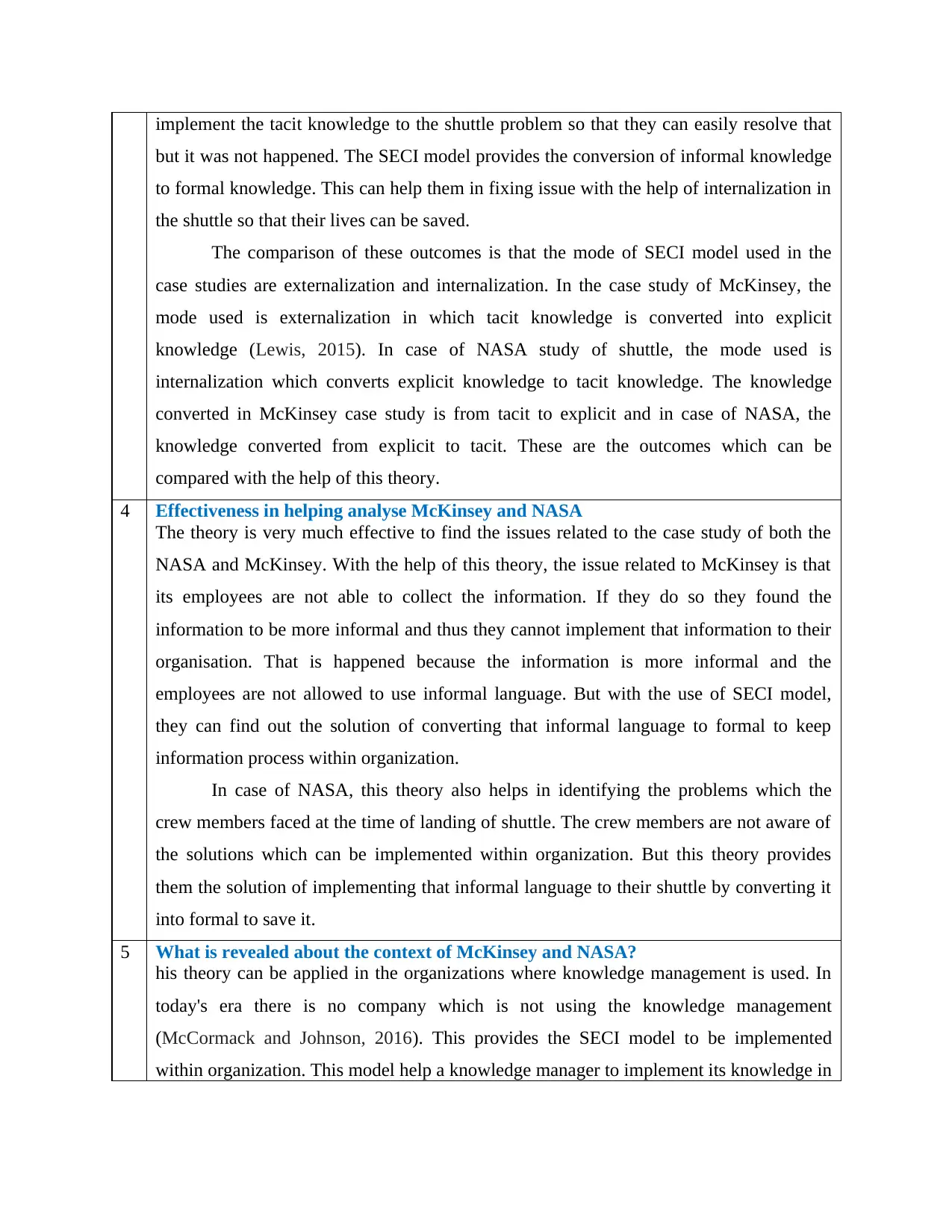
implement the tacit knowledge to the shuttle problem so that they can easily resolve that
but it was not happened. The SECI model provides the conversion of informal knowledge
to formal knowledge. This can help them in fixing issue with the help of internalization in
the shuttle so that their lives can be saved.
The comparison of these outcomes is that the mode of SECI model used in the
case studies are externalization and internalization. In the case study of McKinsey, the
mode used is externalization in which tacit knowledge is converted into explicit
knowledge (Lewis, 2015). In case of NASA study of shuttle, the mode used is
internalization which converts explicit knowledge to tacit knowledge. The knowledge
converted in McKinsey case study is from tacit to explicit and in case of NASA, the
knowledge converted from explicit to tacit. These are the outcomes which can be
compared with the help of this theory.
4 Effectiveness in helping analyse McKinsey and NASA
The theory is very much effective to find the issues related to the case study of both the
NASA and McKinsey. With the help of this theory, the issue related to McKinsey is that
its employees are not able to collect the information. If they do so they found the
information to be more informal and thus they cannot implement that information to their
organisation. That is happened because the information is more informal and the
employees are not allowed to use informal language. But with the use of SECI model,
they can find out the solution of converting that informal language to formal to keep
information process within organization.
In case of NASA, this theory also helps in identifying the problems which the
crew members faced at the time of landing of shuttle. The crew members are not aware of
the solutions which can be implemented within organization. But this theory provides
them the solution of implementing that informal language to their shuttle by converting it
into formal to save it.
5 What is revealed about the context of McKinsey and NASA?
his theory can be applied in the organizations where knowledge management is used. In
today's era there is no company which is not using the knowledge management
(McCormack and Johnson, 2016). This provides the SECI model to be implemented
within organization. This model help a knowledge manager to implement its knowledge in
but it was not happened. The SECI model provides the conversion of informal knowledge
to formal knowledge. This can help them in fixing issue with the help of internalization in
the shuttle so that their lives can be saved.
The comparison of these outcomes is that the mode of SECI model used in the
case studies are externalization and internalization. In the case study of McKinsey, the
mode used is externalization in which tacit knowledge is converted into explicit
knowledge (Lewis, 2015). In case of NASA study of shuttle, the mode used is
internalization which converts explicit knowledge to tacit knowledge. The knowledge
converted in McKinsey case study is from tacit to explicit and in case of NASA, the
knowledge converted from explicit to tacit. These are the outcomes which can be
compared with the help of this theory.
4 Effectiveness in helping analyse McKinsey and NASA
The theory is very much effective to find the issues related to the case study of both the
NASA and McKinsey. With the help of this theory, the issue related to McKinsey is that
its employees are not able to collect the information. If they do so they found the
information to be more informal and thus they cannot implement that information to their
organisation. That is happened because the information is more informal and the
employees are not allowed to use informal language. But with the use of SECI model,
they can find out the solution of converting that informal language to formal to keep
information process within organization.
In case of NASA, this theory also helps in identifying the problems which the
crew members faced at the time of landing of shuttle. The crew members are not aware of
the solutions which can be implemented within organization. But this theory provides
them the solution of implementing that informal language to their shuttle by converting it
into formal to save it.
5 What is revealed about the context of McKinsey and NASA?
his theory can be applied in the organizations where knowledge management is used. In
today's era there is no company which is not using the knowledge management
(McCormack and Johnson, 2016). This provides the SECI model to be implemented
within organization. This model help a knowledge manager to implement its knowledge in
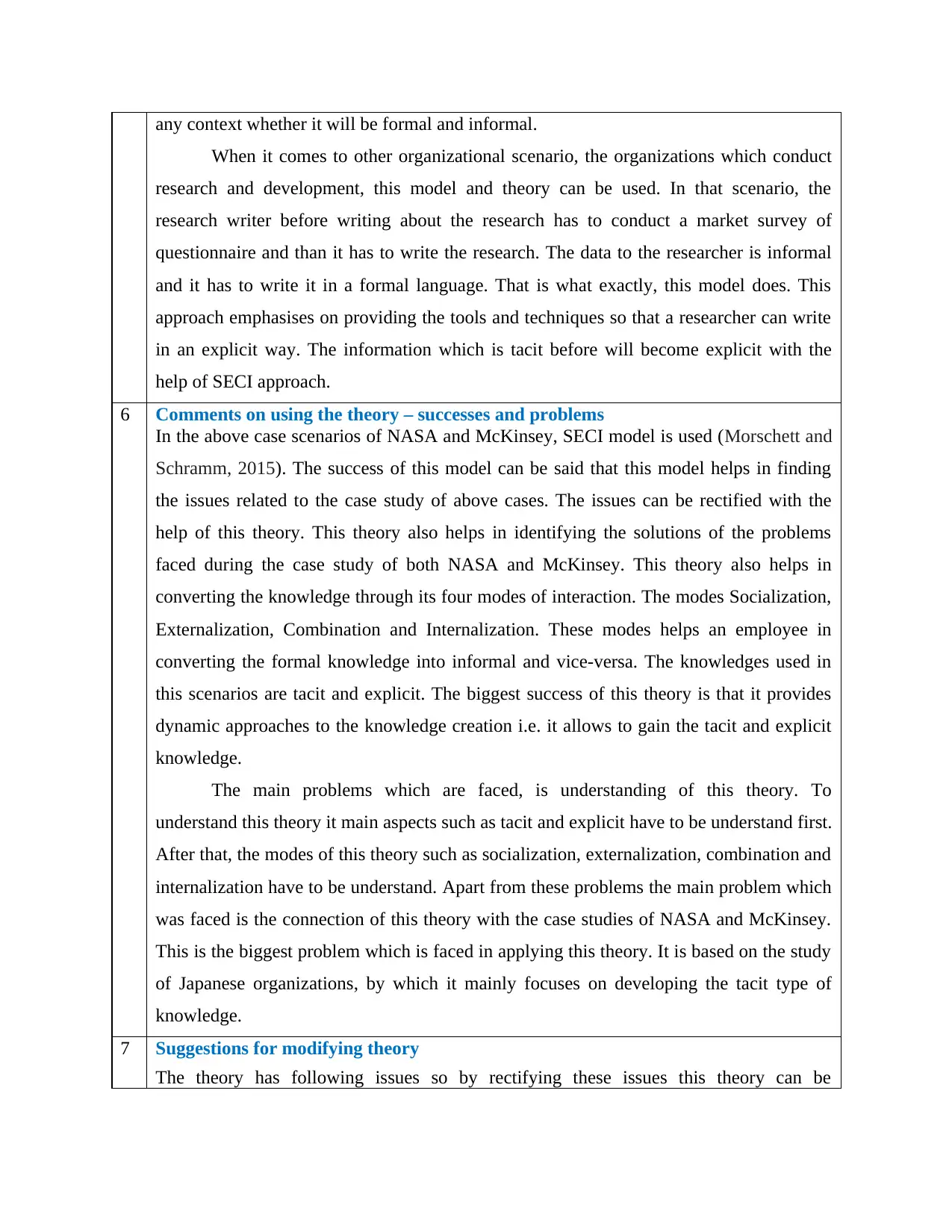
any context whether it will be formal and informal.
When it comes to other organizational scenario, the organizations which conduct
research and development, this model and theory can be used. In that scenario, the
research writer before writing about the research has to conduct a market survey of
questionnaire and than it has to write the research. The data to the researcher is informal
and it has to write it in a formal language. That is what exactly, this model does. This
approach emphasises on providing the tools and techniques so that a researcher can write
in an explicit way. The information which is tacit before will become explicit with the
help of SECI approach.
6 Comments on using the theory – successes and problems
In the above case scenarios of NASA and McKinsey, SECI model is used (Morschett and
Schramm, 2015). The success of this model can be said that this model helps in finding
the issues related to the case study of above cases. The issues can be rectified with the
help of this theory. This theory also helps in identifying the solutions of the problems
faced during the case study of both NASA and McKinsey. This theory also helps in
converting the knowledge through its four modes of interaction. The modes Socialization,
Externalization, Combination and Internalization. These modes helps an employee in
converting the formal knowledge into informal and vice-versa. The knowledges used in
this scenarios are tacit and explicit. The biggest success of this theory is that it provides
dynamic approaches to the knowledge creation i.e. it allows to gain the tacit and explicit
knowledge.
The main problems which are faced, is understanding of this theory. To
understand this theory it main aspects such as tacit and explicit have to be understand first.
After that, the modes of this theory such as socialization, externalization, combination and
internalization have to be understand. Apart from these problems the main problem which
was faced is the connection of this theory with the case studies of NASA and McKinsey.
This is the biggest problem which is faced in applying this theory. It is based on the study
of Japanese organizations, by which it mainly focuses on developing the tacit type of
knowledge.
7 Suggestions for modifying theory
The theory has following issues so by rectifying these issues this theory can be
When it comes to other organizational scenario, the organizations which conduct
research and development, this model and theory can be used. In that scenario, the
research writer before writing about the research has to conduct a market survey of
questionnaire and than it has to write the research. The data to the researcher is informal
and it has to write it in a formal language. That is what exactly, this model does. This
approach emphasises on providing the tools and techniques so that a researcher can write
in an explicit way. The information which is tacit before will become explicit with the
help of SECI approach.
6 Comments on using the theory – successes and problems
In the above case scenarios of NASA and McKinsey, SECI model is used (Morschett and
Schramm, 2015). The success of this model can be said that this model helps in finding
the issues related to the case study of above cases. The issues can be rectified with the
help of this theory. This theory also helps in identifying the solutions of the problems
faced during the case study of both NASA and McKinsey. This theory also helps in
converting the knowledge through its four modes of interaction. The modes Socialization,
Externalization, Combination and Internalization. These modes helps an employee in
converting the formal knowledge into informal and vice-versa. The knowledges used in
this scenarios are tacit and explicit. The biggest success of this theory is that it provides
dynamic approaches to the knowledge creation i.e. it allows to gain the tacit and explicit
knowledge.
The main problems which are faced, is understanding of this theory. To
understand this theory it main aspects such as tacit and explicit have to be understand first.
After that, the modes of this theory such as socialization, externalization, combination and
internalization have to be understand. Apart from these problems the main problem which
was faced is the connection of this theory with the case studies of NASA and McKinsey.
This is the biggest problem which is faced in applying this theory. It is based on the study
of Japanese organizations, by which it mainly focuses on developing the tacit type of
knowledge.
7 Suggestions for modifying theory
The theory has following issues so by rectifying these issues this theory can be
⊘ This is a preview!⊘
Do you want full access?
Subscribe today to unlock all pages.

Trusted by 1+ million students worldwide
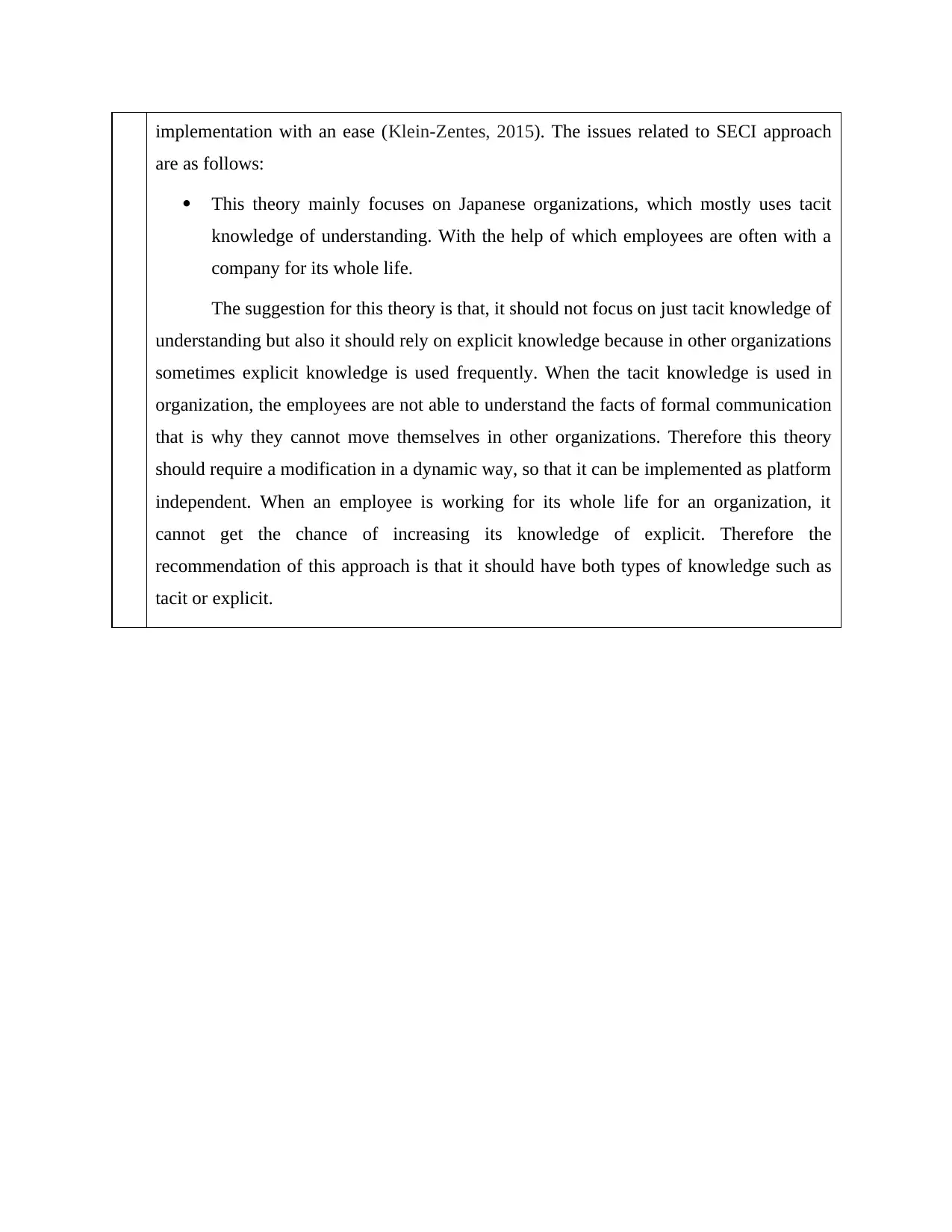
implementation with an ease (Klein-Zentes, 2015). The issues related to SECI approach
are as follows:
This theory mainly focuses on Japanese organizations, which mostly uses tacit
knowledge of understanding. With the help of which employees are often with a
company for its whole life.
The suggestion for this theory is that, it should not focus on just tacit knowledge of
understanding but also it should rely on explicit knowledge because in other organizations
sometimes explicit knowledge is used frequently. When the tacit knowledge is used in
organization, the employees are not able to understand the facts of formal communication
that is why they cannot move themselves in other organizations. Therefore this theory
should require a modification in a dynamic way, so that it can be implemented as platform
independent. When an employee is working for its whole life for an organization, it
cannot get the chance of increasing its knowledge of explicit. Therefore the
recommendation of this approach is that it should have both types of knowledge such as
tacit or explicit.
are as follows:
This theory mainly focuses on Japanese organizations, which mostly uses tacit
knowledge of understanding. With the help of which employees are often with a
company for its whole life.
The suggestion for this theory is that, it should not focus on just tacit knowledge of
understanding but also it should rely on explicit knowledge because in other organizations
sometimes explicit knowledge is used frequently. When the tacit knowledge is used in
organization, the employees are not able to understand the facts of formal communication
that is why they cannot move themselves in other organizations. Therefore this theory
should require a modification in a dynamic way, so that it can be implemented as platform
independent. When an employee is working for its whole life for an organization, it
cannot get the chance of increasing its knowledge of explicit. Therefore the
recommendation of this approach is that it should have both types of knowledge such as
tacit or explicit.
Paraphrase This Document
Need a fresh take? Get an instant paraphrase of this document with our AI Paraphraser

Q
.
Findings
1 Theory and source: Knowledge transitions framework
Knowledge transition: It is the theory in which knowledge is transferred from
individual, person, or group to individual, person or group. Knowledge transfer is a more
complex task as most of the knowledge in organization is of tacit type and its is difficult
of articulate such type of knowledge in the organization. This is a subject of knowledge
management in which it is difficult to transfer knowledge from one part of the
organization to another. The most commonly used application of knowledge transition is
in mergers and acquisition. In it technological platform, market experience, managerial
expertise, advance corporate culture are included therefore it is difficult to transfer
knowledge from one part of organization to other.
2 Outcome of applying theory to McKinsey and NASA
On the other hand Knowledge transition theory specifies about transferring of knowledge
and skills from one person to another. Thus, in case of McKinscey the outcome of this
theory was that with its help the company used to be update about the changes taking
place in the market, whereas in case of NASA shuttle disaster, the outcome was that with
the helps of this theory the lives of the crew member could be easily saved. As with the
helps of this theory the could have easily transferred the knowledge to the crew member
that there was taking place disintegration of spacecraft at its right solid rocket booster.
Thus, it would result in saving life of crew members.
3 Comparison of applications
Whereas, the solution rendered by knowledge transition theory was that with its helps
McKinsey could easily focuses on capturing, managing and disseminating knowledge
across the company. On the other hand in case of NASA this theory were useful as with
its help the life of the crew members could be easily saved as with it help knowledge
could be easily transferred that there taking place and Marshall centre could easily report
this problem to senior management at NASA.
4 Effectiveness in helping analyse McKinsey and NASA
In addition to this with the help of Knowledge transition theory, Manager of the
McKinsey could easily transfer up to date knowledge and it would be easy for the
employees too to collect information and remain up-to-date about the changes taking
place in an organization. In case of NASA this theory would be effective in knowing
.
Findings
1 Theory and source: Knowledge transitions framework
Knowledge transition: It is the theory in which knowledge is transferred from
individual, person, or group to individual, person or group. Knowledge transfer is a more
complex task as most of the knowledge in organization is of tacit type and its is difficult
of articulate such type of knowledge in the organization. This is a subject of knowledge
management in which it is difficult to transfer knowledge from one part of the
organization to another. The most commonly used application of knowledge transition is
in mergers and acquisition. In it technological platform, market experience, managerial
expertise, advance corporate culture are included therefore it is difficult to transfer
knowledge from one part of organization to other.
2 Outcome of applying theory to McKinsey and NASA
On the other hand Knowledge transition theory specifies about transferring of knowledge
and skills from one person to another. Thus, in case of McKinscey the outcome of this
theory was that with its help the company used to be update about the changes taking
place in the market, whereas in case of NASA shuttle disaster, the outcome was that with
the helps of this theory the lives of the crew member could be easily saved. As with the
helps of this theory the could have easily transferred the knowledge to the crew member
that there was taking place disintegration of spacecraft at its right solid rocket booster.
Thus, it would result in saving life of crew members.
3 Comparison of applications
Whereas, the solution rendered by knowledge transition theory was that with its helps
McKinsey could easily focuses on capturing, managing and disseminating knowledge
across the company. On the other hand in case of NASA this theory were useful as with
its help the life of the crew members could be easily saved as with it help knowledge
could be easily transferred that there taking place and Marshall centre could easily report
this problem to senior management at NASA.
4 Effectiveness in helping analyse McKinsey and NASA
In addition to this with the help of Knowledge transition theory, Manager of the
McKinsey could easily transfer up to date knowledge and it would be easy for the
employees too to collect information and remain up-to-date about the changes taking
place in an organization. In case of NASA this theory would be effective in knowing
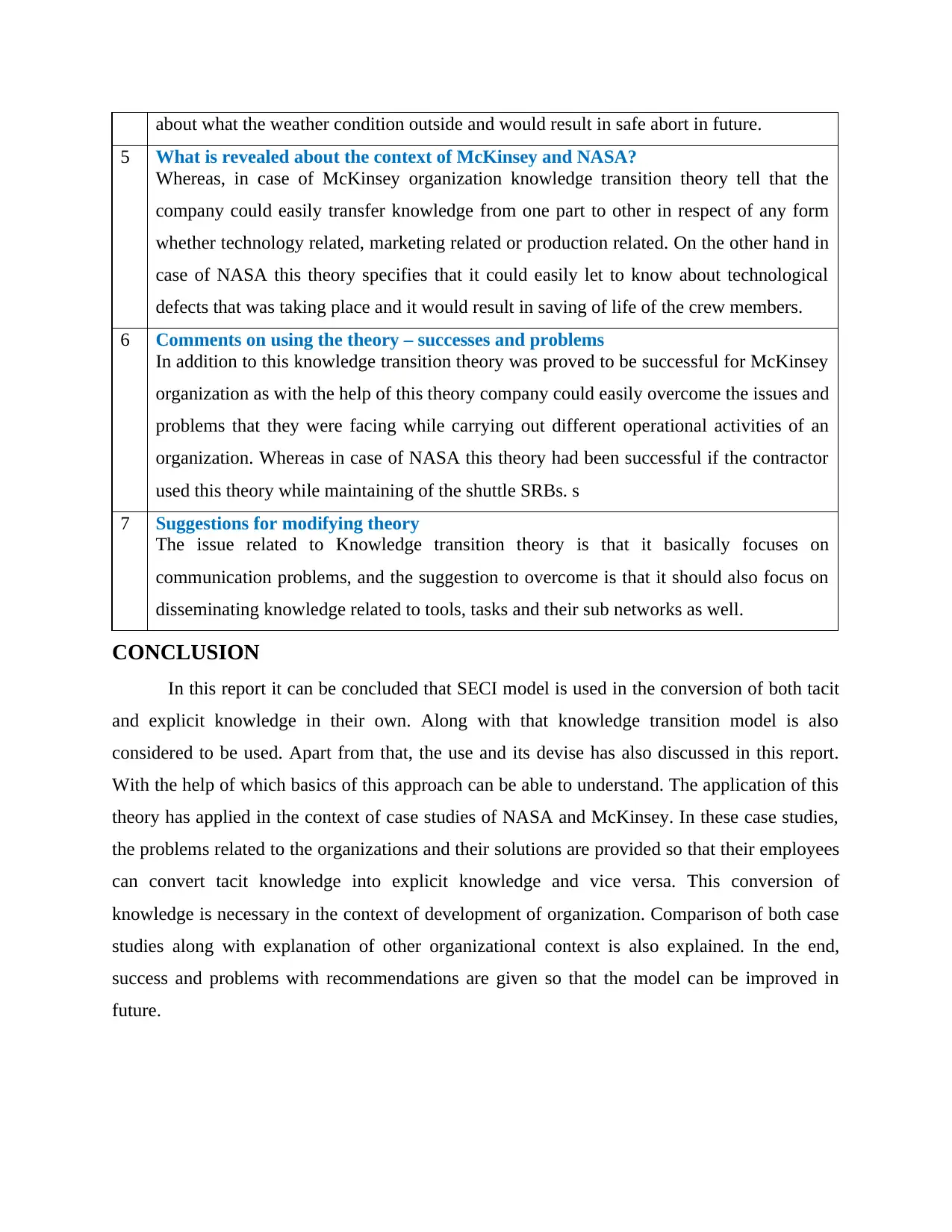
about what the weather condition outside and would result in safe abort in future.
5 What is revealed about the context of McKinsey and NASA?
Whereas, in case of McKinsey organization knowledge transition theory tell that the
company could easily transfer knowledge from one part to other in respect of any form
whether technology related, marketing related or production related. On the other hand in
case of NASA this theory specifies that it could easily let to know about technological
defects that was taking place and it would result in saving of life of the crew members.
6 Comments on using the theory – successes and problems
In addition to this knowledge transition theory was proved to be successful for McKinsey
organization as with the help of this theory company could easily overcome the issues and
problems that they were facing while carrying out different operational activities of an
organization. Whereas in case of NASA this theory had been successful if the contractor
used this theory while maintaining of the shuttle SRBs. s
7 Suggestions for modifying theory
The issue related to Knowledge transition theory is that it basically focuses on
communication problems, and the suggestion to overcome is that it should also focus on
disseminating knowledge related to tools, tasks and their sub networks as well.
CONCLUSION
In this report it can be concluded that SECI model is used in the conversion of both tacit
and explicit knowledge in their own. Along with that knowledge transition model is also
considered to be used. Apart from that, the use and its devise has also discussed in this report.
With the help of which basics of this approach can be able to understand. The application of this
theory has applied in the context of case studies of NASA and McKinsey. In these case studies,
the problems related to the organizations and their solutions are provided so that their employees
can convert tacit knowledge into explicit knowledge and vice versa. This conversion of
knowledge is necessary in the context of development of organization. Comparison of both case
studies along with explanation of other organizational context is also explained. In the end,
success and problems with recommendations are given so that the model can be improved in
future.
5 What is revealed about the context of McKinsey and NASA?
Whereas, in case of McKinsey organization knowledge transition theory tell that the
company could easily transfer knowledge from one part to other in respect of any form
whether technology related, marketing related or production related. On the other hand in
case of NASA this theory specifies that it could easily let to know about technological
defects that was taking place and it would result in saving of life of the crew members.
6 Comments on using the theory – successes and problems
In addition to this knowledge transition theory was proved to be successful for McKinsey
organization as with the help of this theory company could easily overcome the issues and
problems that they were facing while carrying out different operational activities of an
organization. Whereas in case of NASA this theory had been successful if the contractor
used this theory while maintaining of the shuttle SRBs. s
7 Suggestions for modifying theory
The issue related to Knowledge transition theory is that it basically focuses on
communication problems, and the suggestion to overcome is that it should also focus on
disseminating knowledge related to tools, tasks and their sub networks as well.
CONCLUSION
In this report it can be concluded that SECI model is used in the conversion of both tacit
and explicit knowledge in their own. Along with that knowledge transition model is also
considered to be used. Apart from that, the use and its devise has also discussed in this report.
With the help of which basics of this approach can be able to understand. The application of this
theory has applied in the context of case studies of NASA and McKinsey. In these case studies,
the problems related to the organizations and their solutions are provided so that their employees
can convert tacit knowledge into explicit knowledge and vice versa. This conversion of
knowledge is necessary in the context of development of organization. Comparison of both case
studies along with explanation of other organizational context is also explained. In the end,
success and problems with recommendations are given so that the model can be improved in
future.
⊘ This is a preview!⊘
Do you want full access?
Subscribe today to unlock all pages.

Trusted by 1+ million students worldwide
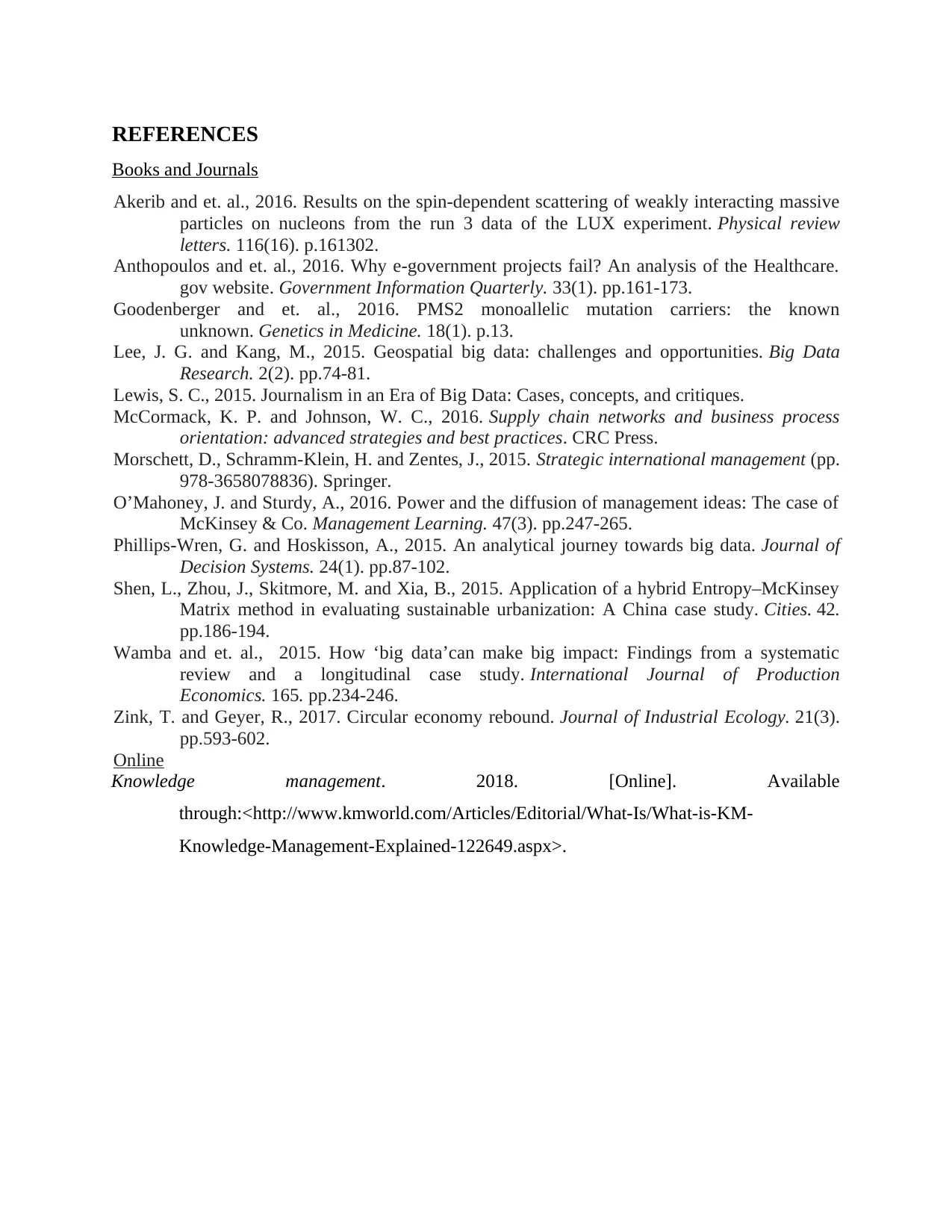
REFERENCES
Books and Journals
Akerib and et. al., 2016. Results on the spin-dependent scattering of weakly interacting massive
particles on nucleons from the run 3 data of the LUX experiment. Physical review
letters. 116(16). p.161302.
Anthopoulos and et. al., 2016. Why e-government projects fail? An analysis of the Healthcare.
gov website. Government Information Quarterly. 33(1). pp.161-173.
Goodenberger and et. al., 2016. PMS2 monoallelic mutation carriers: the known
unknown. Genetics in Medicine. 18(1). p.13.
Lee, J. G. and Kang, M., 2015. Geospatial big data: challenges and opportunities. Big Data
Research. 2(2). pp.74-81.
Lewis, S. C., 2015. Journalism in an Era of Big Data: Cases, concepts, and critiques.
McCormack, K. P. and Johnson, W. C., 2016. Supply chain networks and business process
orientation: advanced strategies and best practices. CRC Press.
Morschett, D., Schramm-Klein, H. and Zentes, J., 2015. Strategic international management (pp.
978-3658078836). Springer.
O’Mahoney, J. and Sturdy, A., 2016. Power and the diffusion of management ideas: The case of
McKinsey & Co. Management Learning. 47(3). pp.247-265.
Phillips-Wren, G. and Hoskisson, A., 2015. An analytical journey towards big data. Journal of
Decision Systems. 24(1). pp.87-102.
Shen, L., Zhou, J., Skitmore, M. and Xia, B., 2015. Application of a hybrid Entropy–McKinsey
Matrix method in evaluating sustainable urbanization: A China case study. Cities. 42.
pp.186-194.
Wamba and et. al., 2015. How ‘big data’can make big impact: Findings from a systematic
review and a longitudinal case study. International Journal of Production
Economics. 165. pp.234-246.
Zink, T. and Geyer, R., 2017. Circular economy rebound. Journal of Industrial Ecology. 21(3).
pp.593-602.
Online
Knowledge management. 2018. [Online]. Available
through:<http://www.kmworld.com/Articles/Editorial/What-Is/What-is-KM-
Knowledge-Management-Explained-122649.aspx>.
Books and Journals
Akerib and et. al., 2016. Results on the spin-dependent scattering of weakly interacting massive
particles on nucleons from the run 3 data of the LUX experiment. Physical review
letters. 116(16). p.161302.
Anthopoulos and et. al., 2016. Why e-government projects fail? An analysis of the Healthcare.
gov website. Government Information Quarterly. 33(1). pp.161-173.
Goodenberger and et. al., 2016. PMS2 monoallelic mutation carriers: the known
unknown. Genetics in Medicine. 18(1). p.13.
Lee, J. G. and Kang, M., 2015. Geospatial big data: challenges and opportunities. Big Data
Research. 2(2). pp.74-81.
Lewis, S. C., 2015. Journalism in an Era of Big Data: Cases, concepts, and critiques.
McCormack, K. P. and Johnson, W. C., 2016. Supply chain networks and business process
orientation: advanced strategies and best practices. CRC Press.
Morschett, D., Schramm-Klein, H. and Zentes, J., 2015. Strategic international management (pp.
978-3658078836). Springer.
O’Mahoney, J. and Sturdy, A., 2016. Power and the diffusion of management ideas: The case of
McKinsey & Co. Management Learning. 47(3). pp.247-265.
Phillips-Wren, G. and Hoskisson, A., 2015. An analytical journey towards big data. Journal of
Decision Systems. 24(1). pp.87-102.
Shen, L., Zhou, J., Skitmore, M. and Xia, B., 2015. Application of a hybrid Entropy–McKinsey
Matrix method in evaluating sustainable urbanization: A China case study. Cities. 42.
pp.186-194.
Wamba and et. al., 2015. How ‘big data’can make big impact: Findings from a systematic
review and a longitudinal case study. International Journal of Production
Economics. 165. pp.234-246.
Zink, T. and Geyer, R., 2017. Circular economy rebound. Journal of Industrial Ecology. 21(3).
pp.593-602.
Online
Knowledge management. 2018. [Online]. Available
through:<http://www.kmworld.com/Articles/Editorial/What-Is/What-is-KM-
Knowledge-Management-Explained-122649.aspx>.
1 out of 10
Related Documents
Your All-in-One AI-Powered Toolkit for Academic Success.
+13062052269
info@desklib.com
Available 24*7 on WhatsApp / Email
![[object Object]](/_next/static/media/star-bottom.7253800d.svg)
Unlock your academic potential
Copyright © 2020–2025 A2Z Services. All Rights Reserved. Developed and managed by ZUCOL.





